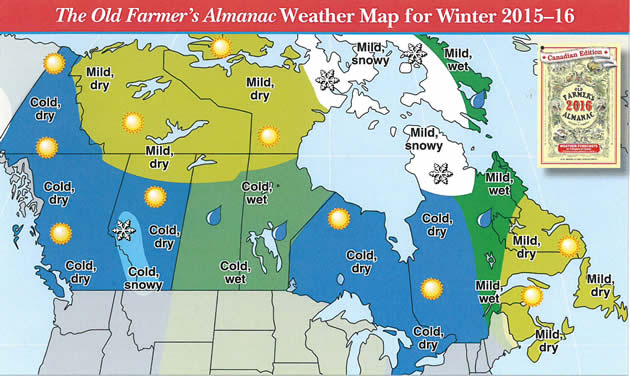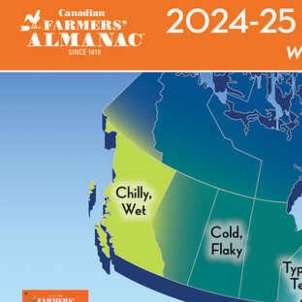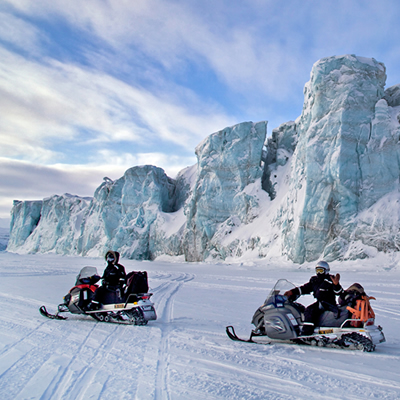For an updated version of this story, see our Weather Predictions for the 2016-2017 snowmobiling season in Western Canada.
Warm temperatures and low snowfall was a common theme across Western Canada last winter. Since then, thoughts of selling sleds or moving East, I’m sure, have crossed many a snowmobiler’s mind. Spirits are low and the hot, dry summer we just had certainly doesn’t inspire much confidence in the months ahead.
Fortunately, Jack Burnett, managing editor of the Old Farmer’s Almanac - Canadian Edition, has some good news for snowmobilers in Western Canada: “It looks to me that it’s going to be a pretty great snowmobiling year.”
The Old Farmer’s Almanac came out in August and with it, the 2015-2016 winter weather forecast.
Looking at it by province, the Almanac predicts a colder than normal winter in B.C., and snowfall will generally be below normal. That’s good news? Well, according to Burnett, snow levels will be down, but not by much. And thanks to the cold, the stuff that does fall on the ground shouldn’t turn to mashed potatoes.
“Even if we have slightly less snow in B.C.,” said Burnett, “it’s the cold that we really want to have so it doesn’t turn to water and mud.”
In Alberta, winter will have a bit of a split personality. While most of the province will see colder than normal temperatures and below normal snowfall, Burnett said, the Calgary area is likely to see colder temperatures and more snow than normal.
Saskatchewan and Manitoba can look forward to what Burnett calls the “The Big Chill.”
“We’re looking at it being colder than normal,” he said, “and we’re actually looking for more snow than normal in Saskatchewan and Manitoba.”
More good news is that the snowiest times in Western Canada will be during the holidays: mid-December and early to mid-January. Saskatchewan and Manitoba may also see a good batch of new snow arrive in late March.
“It’s looking pretty good for vacation periods,” said Burnett.
What happened to El Niño?
The Old Farmer’s Almanac doesn’t dismiss the possibility of an El Niño hitting the western seaboard this winter, but the prediction is that it will be in more of a weak to neutral phase, as opposed to the strongest of strong El Niños that scientists have been tracking.
Burnett, however, is hoping the Almanac is wrong.
He said, “It’s one of the few times in our history where we said, ‘here’s what we think, but we hope we are wrong,’ because if we are wrong, then it’s good for the drought-stricken people.”
An El Niño occurs when a change in the normal wind direction causes ocean waters off the coast of central America to warm up. The result is more rain on the coast and drier, milder weather inland.
“If it’s a strong one, that means the West Coast of the U.S. and B.C. will be getting more rain and more storms,” said Burnett.
Mountain sledders know what that means: lots of snow at higher elevations. But for those who spend most of their time riding in the lower levels, an El Niño could bring a similar or worse situation as last year. Either way, Burnett is confident this year will be a good one for sledders.
“There’s so much going on off the West Coast of B.C. and the U.S. that it’s going to be hard for there not to be good snowmobiling,” he said.
How the Old Farmer’s Almanac predicts the weather
Predicting the weather a year and a half in advance is no easy task. How does the Old Farmer’s Almanac do it?
According to Burnett, the prediction is based on a 224-year-old formula that takes into account local weather patterns, climatology and solar radiation. He said the same data that is collected by Environment Canada is entered into a computer and the formula, which has long since been converted to computer algorithms, is used to determine the forecast.
“We give a great deal of credibility to the importance of cycles,” said Burnett.
The Old Farmer’s Almanac has been criticized for its methods of predicting the weather, but doesn’t every long-range weather forecast need to be taken with a grain of salt? The good thing about this publication is that if the weather reports change elsewhere, the Almanac doesn’t change its forecast.
“We’ve always been about 80 per cent correct by sticking to our guns,” said Burnett.
Only time will tell, and whether you are rooting for El Niño or not, now is a good time to cross your fingers and pray for snow.
Was the Old Farmer’s Almanac - Canadian Edition accurate in its predictions for last winter? See our story, Weather Predictions for the 2014-2015 Sledding Season.







